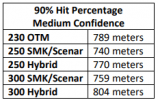Bryan Litz authored the article
"Weapon Employment Zone (WEZ) Analysis of the Optimized 300 Winchester Magnum vs 338 Lapua Magnum With Various Ammunition Types." The article reports a scientific analysis comparing the ballistic performance of the Berger 230-grain OTM 30-caliber bullet loaded for the 300 Win Mag, with 250- and 300-grain .338 Scenar and Berger Hybrid bullets loaded for the 338 Lapua, in high- and medium-confidence shooting environments. (Clearly Litz wrote to a military audience.) The analysis assumes the shooter will have a rangefinder, the ammo's muzzle velocity will have a standard deviation under 20 fps, and retained kinetic energy must be at least 1,000 ft-lbs. The article quantifies ballistic performance in terms of retained energy and velocity, and the hit rate on a standard IPSC target.
The 300 Mag performs slightly better than all or most of the 338 loads for some metrics, and slightly worse than some (but not all) 338 loads for others. For example, consider the maximum distance at which a load achieves a 90% hit percentage in a medium-confidence environment:
View attachment 296470
Only the 300-grain Berger Hybrid .338 load (very slightly) outperforms the 300 Win Mag 230 OTM.
As for terminal performance, Litz remarks that "all [five] bullets under consideration are of similar construction: open tip, match bullets with relatively thick copper jackets and lead cores. This type of construction produces the most precise bullets available, while achieving desired terminal performance which is characterized by limited penetration at short range (high velocity) and high weight retention and penetration at long range (low velocity) impacts. All [five] of the bullets under consideration share the same materials and construction, and exhibit the same desirable terminal performance attributes."
The article's overall conclusion is that the two calibers perform very closely, to the degree that some differences "can only really be resolved by elite shooters in the highest-confidence environments." Litz concludes, "if loaded with the 230 grain Berger OTM Hybrid option, the 300 Win Mag is very comparable in performance, achieving similar hit percentages as the 338 Lapua Mag with all bullet options. In fact, the 300 Win Mag loaded with the 230 OTM bullet outperforms both 250 and 300 grain Sierra MatchKing bullets in .338.
But the 338 Lapua Mag loaded with either 250 or 300 grain Berger Hybrids will outperform the 300 Win Mag loaded with 230 OTMs" (italics mine).
It seems the science is on your side.
I'd be curious to see the paper's analysis repeated comparing the 230 OTM loaded for a 300 RUM. The differences between the 300 Win Mag and the 338 Lapua are slight enough that an extra 100 fps or so might even things up. I doubt they'd tip the scales to favor the 300 across the board. However, the analysis did lead me to re-barrel my 300 RUM Sendero with a 28" 1:9 twist 300 RUM, so I can shoot 230-grain 30-caliber Berger Hybrids and Hornady A-Tips, rather than spending a lot more to build a 338 Lapua. Whatever the 338's advantages might be, I'll never be an elite shooter hunting elk in the highest-confidence environments. "I'm just a peckerwood who lives in the hills with too many guns."

